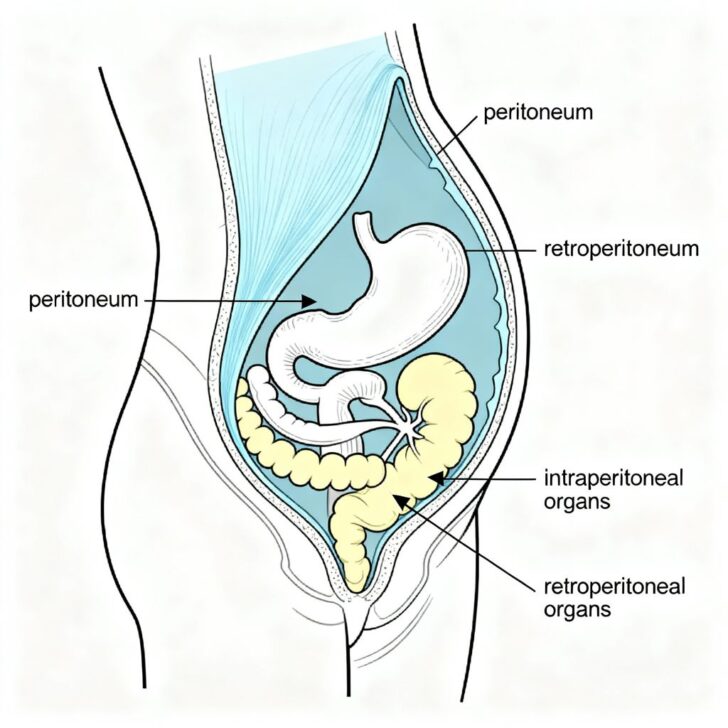Most people don’t know the difference between the peritoneum and retroperitoneum – but it’s actually an important distinction to make. The peritoneum is a membrane that lines the abdominal cavity, while the retroperitoneum is the area behind that membrane. In this article, we’ll explore the different functions of these two areas and how they work together.
-
The peritoneum is a thin, serous membrane that lines the abdominal cavity (parietal peritoneum) and covers the abdominal organs (visceral peritoneum).
-
It forms a closed sac in the abdomen with two layers and a small potential space between them called the peritoneal cavity filled with lubricating fluid, allowing organ movement.
-
The peritoneum supports the organs by suspending them with mesenteries, omenta, and ligaments.
-
Organs that are almost completely covered by the visceral peritoneum and suspended by mesenteries are called intraperitoneal organs (e.g., stomach, liver, spleen, jejunum, ileum, transverse colon).
-
The peritoneum provides protection, facilitates movement without friction between organs, and houses blood vessels, lymphatics, and nerves.
What is the Retroperitoneum?
-
The retroperitoneum (retroperitoneal space) refers to the anatomical space located behind (retro) the peritoneum.
-
It is a potential space between the parietal peritoneum and the posterior abdominal wall.
-
Organs in this space are covered only on their anterior side by the parietal peritoneum, not surrounded by peritoneum, making them retroperitoneal organs.
-
Some organs are primarily retroperitoneal, meaning they developed outside the peritoneum—kidneys, adrenal glands, aorta, inferior vena cava.
-
Other organs are secondarily retroperitoneal, meaning they initially were intraperitoneal but later migrated behind the peritoneum during development—pancreas, ascending and descending colon, parts of the duodenum.
Differences Summary
| Aspect | Peritoneum | Retroperitoneum |
|---|---|---|
| Location | Serous membrane lining abdominal cavity and organs | Space behind the peritoneum and anterior to spine |
| Layers | Parietal (abdominal wall) and visceral (organ surface) | Covered only anteriorly by parietal peritoneum |
| Organ Types | Intraperitoneal organs (completely covered) | Retroperitoneal organs (partial or no peritoneal covering) |
| Organ Mobility | Usually mobile (attached by mesentery) | Usually fixed to posterior wall |
| Examples of Organs | Stomach, liver, spleen, jejunum, ileum, transverse and sigmoid colon | Kidneys, adrenal glands, pancreas, duodenum, aorta, IVC |
| Function/Role | Supports, protects organs; allows organ movement | Houses major vessels and fixed organs; less movable |
Clinical Relevance
-
The peritoneal cavity may fill with fluid during inflammation (ascites) or infection (peritonitis).
-
Retroperitoneal organs’ fixed position influences surgical approaches and the spread of infections or bleeding.
-
Retroperitoneal space anatomy is important for radiological interpretation and trauma assessment.
How to Determine Which One You Have
If you’re not sure whether you have peritoneum or retroperitoneum, there are a few ways to tell the difference. First, look at your abdomen. If your abdominal cavity is completely filled with organs, then you have peritoneum. If your abdominal cavity is only partially filled with organs, then you have retroperitoneum.
Another way to tell the difference is by looking at your pelvis. If your pelvic bones are surrounded by peritoneum, then you have peritoneum. If your pelvic bones are surrounded by retroperitoneum, then you have retroperitoneum.
Finally, you can also ask your doctor for a CT scan or MRI. These imaging tests will show whether you have peritoneum or retroperitoneum.
Treatment for Peritoneal and Retroperitoneal Conditions
The peritoneum is the thin layer of tissue that lines the abdominal cavity and covers the abdominal organs. The retroperitoneum is the space behind the peritoneum.
Peritoneal and retroperitoneal conditions are treated differently because of their different locations in the body. Peritoneal conditions are treated with surgery, while retroperitoneal conditions are treated with medications.
Conclusion
In conclusion, the peritoneum is a serous membrane that covers the abdominal cavity and some of the organs within it. The retroperitoneum is located behind the peritoneum and contains the kidneys, adrenal glands, pancreas, and other structures.
